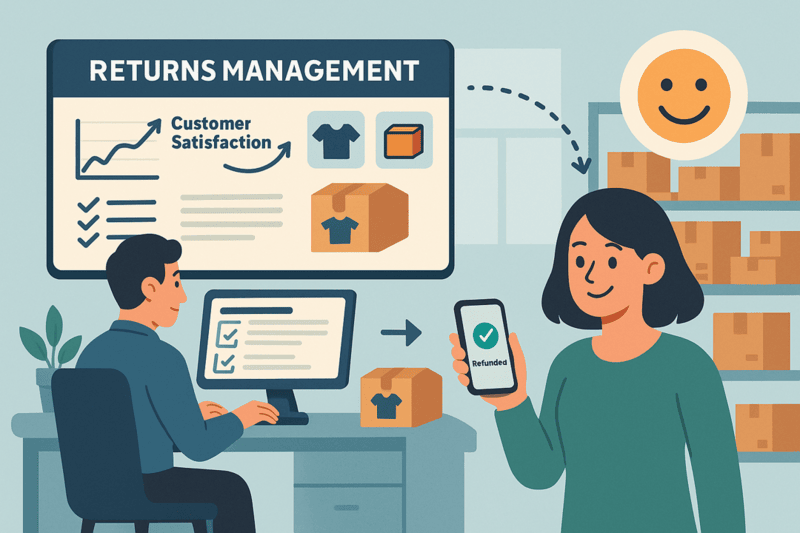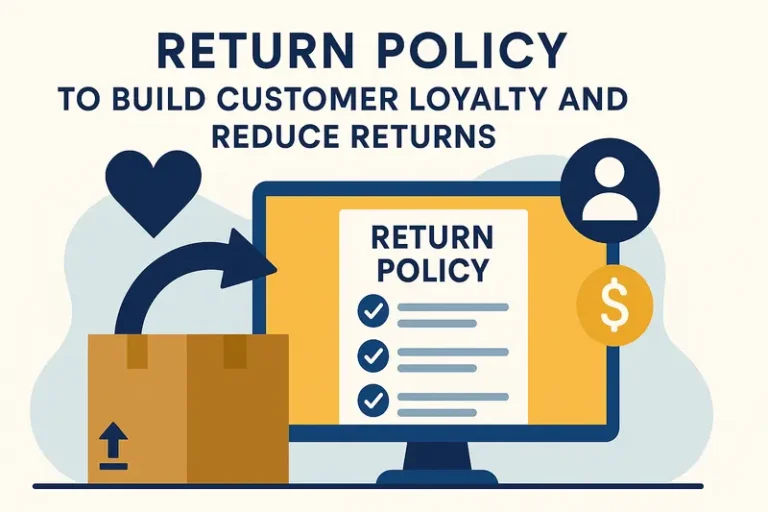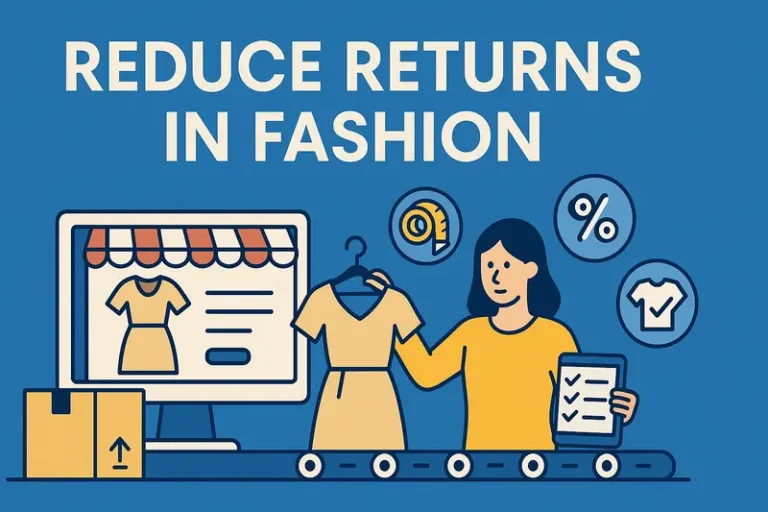Loop Returns vs Narvar vs Aftership: Which Returns Software is Right for Your Store?

Last updated on May 1, 2025

In this article
 20 minutes
20 minutes
- Key Takeaways
- Understanding the Importance of Ecommerce Returns Management
- Common Reasons for Ecommerce Returns
- The Cost of Ecommerce Returns
- Effective Strategies for Managing Ecommerce Returns
- Utilizing Technology in Returns Management
- Sustainability in Ecommerce Returns
- Communicating with Customers During Returns
- Overview of the Three Returns Software Platforms
- Comparing Loop Returns, Narvar, and Aftership: Key Differences and Similarities
- Factors to Consider When Choosing a Return Platform for Your Ecommerce Store
- How to Implement the Right Returns Software for Your Store
- Summary
- Frequently Asked Questions
Effective ecommerce returns management is crucial for reducing costs and keeping customers satisfied. Efficient returns processes can improve your operations and boost customer loyalty. This article compares Loop Returns, Narvar, and Aftership, helping you choose the best returns management software for your store.
Key Takeaways
- Effective ecommerce returns management can enhance customer satisfaction, loyalty, and operational efficiency, transforming returns from a burden into a competitive advantage.
- Understanding common return reasons, like inaccurate product descriptions and poor quality, can help businesses minimize return rates and improve overall customer experience.
- Choosing the right returns software, such as Loop Returns, Narvar, or Aftership, requires evaluating integration capabilities, customer expectations, scalability, and sustainability to align with your business needs.
Understanding the Importance of Ecommerce Returns Management

Effective ecommerce returns management is not just a logistical necessity, it’s a strategic advantage that can set your ecommerce business apart from the competition. With the rise of online shopping, managing returns efficiently has become integral to maintaining customer satisfaction and loyalty. A well-oiled returns process can significantly impact your profit margins and operational efficiency, fostering a positive shopping experience that keeps customers coming back, as opposed to never having had the opportunity to start a new and fruitful relationship.
Retailers often perceive returns as a negative aspect of their operations. However, embracing returns as a valuable touchpoint in the buyer’s journey can enhance overall customer engagement and differentiate your brand. Enhancing the returns experience eases friction, reduces support bandwidth, and allows you to use returns data for optimization, ultimately building trust and fostering long-term customer loyalty.
Ecommerce businesses face several challenges in managing returns, from complex processes to friction in the customer journey. Yet, an effective returns management process not only solves these issues but also improves the overall customer experience and operational flow, making returns a competitive advantage rather than a burden.
Make Returns Profitable, Yes!
Cut shipping and processing costs by 70% with our patented peer-to-peer returns solution. 4x faster than traditional returns.
See How It WorksCustomer Satisfaction and Loyalty
A straightforward and hassle-free returns process can significantly boost customer satisfaction. When customers know they can return items easily, they’re more likely to trust your brand and make repeated purchases. Offering free return shipping and displaying clear return policies prominently can enhance customer loyalty, meet customer expectations, and drive sales.
Sustainable returns practices are becoming increasingly important to consumers. By meeting the growing demand for environmentally conscious options, you can improve brand loyalty and attract a more conscientious customer base.
Clear expectations and accurate product descriptions also help reduce return fraud, fostering a trustworthy relationship with your customers.
Profit Margins and Operational Efficiency
Maintaining healthy profit margins in ecommerce requires a well-managed returns process. Effective returns management can lead to significant cost savings by reducing labor costs, improving inventory management, and enhancing operational efficiency. Analyzing customer purchase patterns allows businesses to provide better product suggestions, reducing the likelihood of returns and increasing revenue.
However, balancing cost savings with customer satisfaction is crucial. Positive product reviews and customer feedback can boost sales and contribute to long-term customer value, making the investment in a good returns management process worthwhile. By setting clear expectations and accurate product descriptions, you can minimize return rates and improve overall profitability.
Common Reasons for Ecommerce Returns

Understanding why customers return products is essential for managing returns effectively. Common reasons include products not being as described, poor quality or damaged items, and incorrect size or fit. Addressing these issues reduces return rates and enhances the customer experience.
Impulse buying and buyer’s remorse also contribute to returns. Customers often make quick decisions as online shoppers, only to regret them later. Providing detailed product descriptions, sizing guides, and high-quality images can help set accurate expectations, minimizing the chances of returns due to buyer’s remorse.
Product Not as Described
Accurate product descriptions are crucial in preventing returns due to misrepresentation. A significant number of shoppers return items because they do not match their expectations or the product images. Providing high-quality images and using augmented reality can help customers make informed decisions, reducing the likelihood of returns.
For example, 36% of shoppers are frustrated by insufficient product information, and 23% return items due to inaccurate descriptions (DHL). Improving product descriptions and utilizing AR tools enhances customer satisfaction and reduces return rates.
Poor Quality or Damaged Items
Poor quality or damaged items are common reasons for returns. Ensuring high-quality products and secure packaging can significantly reduce return rates. Items often arrive faulty or damaged due to issues in transit, making secure packaging crucial.
When products are damaged during shipping, replacing them promptly is essential to maintain customer trust. However, damaged goods that cannot be repaired are considered a complete loss, highlighting the importance of quality checks and robust packaging solutions to ship items securely.
Incorrect Size or Fit
Incorrect size or fit is a major reason for returns, especially for clothing and shoes. Providing detailed sizing guides and fitting tools for multiple sizes can help minimize these returns.
Augmented reality and 3D visualization tools allow customers to visualize products in their environment, enhancing their buying confidence and reducing return rates.
The Cost of Ecommerce Returns
Ecommerce returns come with various costs, including labor, reselling, and logistics. These costs can significantly impact profit margins, making it essential to manage returns efficiently. Neglecting the cost of ecommerce returns, such as return shipping and processing, can complicate financial planning and affect overall profitability.
Return fraud is another significant cost, leading to substantial financial losses for retailers. Implementing efficient returns processes can help recover value from returned items, reduce logistics costs, and improve financial performance.
Labor Costs
Processing returns is labor-intensive and often requires specialized teams. Tasks like opening boxes, identifying products, and restocking inventory demand significant resources, impacting overall operational costs. Understanding these labor costs is vital for managing returns effectively and ensuring efficient processing.
Reselling and Restocking
Reselling returned items in the retail business involves operational challenges like determining their condition and repackaging them. Quickly restocking these items is essential to minimize inventory disruption and recover potential losses.
Efficient inventory management and reverse logistics are crucial in efficiently managing this process.
Transportation and Logistics
Transportation costs, including fuel and equipment maintenance, are significant in the returns process. Efficient logistics and secure shipping can reduce these costs, ensuring that returned items are handled properly and minimizing damage during transit.
Effective Strategies for Managing Ecommerce Returns
Implementing effective strategies for managing returns can elevate customer satisfaction and operational efficiency. Clear and accessible return policies, automating the returns process, and encouraging exchanges or store credit are key strategies to consider.
Using third-party logistics (3PL) for returns management allows retailers to outsource the time-consuming process of handling returns, streamlining operations and improving customer experiences. Integrating technology into returns management can significantly enhance efficiency by automating tasks and providing real-time tracking.
Clear and Accessible Return Policies
Having clear and accessible returns policy is essential for protecting your business and enhancing customer satisfaction. Link your return policy in the website footer and during checkout to ensure customers can easily find it.
Accurate product descriptions also help reduce the likelihood of returns by setting clear expectations.
Automating the Returns Process
Automating the returns process can significantly reduce manual tasks and improve operational efficiency. Returns management software can streamline the workflow, allowing businesses to handle returns more efficiently. By reducing the steps involved in processing returns, retailers can save time, cut down on manual errors, and improve the overall returns experience for customers.
Using return management apps can further save retailers time on manual returns. Seamless integration of returns software reduces manual data entry errors and provides a streamlined process that enhances overall efficiency. Automating refunds and exchanges can also ensure that customers receive their refunds or replacements promptly, improving customer satisfaction.
Encouraging Exchanges or Store Credit
Encouraging exchanges or store credit instead of refunds can significantly enhance customer loyalty and retain sales revenue. Offering store credit or exchanges helps minimize the impact of returns on overall revenue, as customers are likely to use the credit for future purchases, especially during in-store sales.
Providing incentives for customers to retain products, such as discounts on future purchases, can effectively lower return rates and improve customer satisfaction.
Convert Returns Into New Sales and Profits
Our peer-to-peer returns system instantly resells returned items—no warehouse processing, and get paid before you refund.
I'm Interested in Peer-to-Peer ReturnsUtilizing Technology in Returns Management
Technology plays a crucial role in improving returns management by streamlining processes and enhancing operational efficiency. Unified commerce, which integrates all sales channels into a single system, can make returns management more efficient and improve the customer experience. With real-time data, items can be immediately added back to inventory after returns, ensuring accurate inventory management.
The integration of technology in returns management can lead to significant improvements in handling returns. Returns management software, AR tools, and 3D visualization tools can all contribute to a more efficient and customer-friendly returns process. These technologies help reduce return rates by providing customers with better tools to make informed purchasing decisions.
Returns Management Software
Returns management software is essential for simplifying and streamlining the returns process in ecommerce. For instance, Happy Returns offers services like box-free returns and a network of over 8,000 Return Bar locations for customer convenience.
Automating the post-purchase process can significantly reduce operational headaches for ecommerce merchants, allowing them to focus on other aspects of their business.
Integration with Ecommerce Platforms
Integrating returns software with existing ecommerce platforms allows for streamlined operations and improved customer experience. Real-time tracking information helps customers manage their expectations regarding delivery and refunds, enhancing overall satisfaction.
Seamless integration also reduces manual effort and improves operational efficiency, benefiting both the retailer and the customer.
Implementing AR and 3D Tools
Augmented reality (AR) and 3D visualization tools enhance the online shopping experience by allowing customers to virtually try products before purchasing. AR technology enables customers to visualize products in their space, aiding in accurate size and fit assessments, which can significantly reduce return rates.
High-quality images and engaging content through social media also help customers make informed decisions, further minimizing returns.
Sustainability in Ecommerce Returns

Sustainability in returns management is crucial for reducing environmental impact and addressing customer concerns. Maintaining a sustainable returns process involves using eco-friendly packaging, reducing carbon footprint, and encouraging responsible returns practices. These practices not only benefit the environment but also enhance customer satisfaction and loyalty.
By returning products to the sales supply chain instead of sending them to landfills, businesses can significantly reduce waste and environmental damage. Educating consumers about sustainable return practices can foster more environmentally conscious behavior and further reduce waste.
Businesses are encouraged to adopt eco-friendly packaging solutions to minimize their ecological footprint.
Eco-Friendly Packaging
Sustainable packaging practices, such as using recyclable and biodegradable materials, contribute to a less harmful environment. By returning products to the supply chain, businesses can reduce waste and environmental damage.
Educating consumers about sustainable return practices can foster more environmentally conscious behavior and reduce waste, ultimately benefiting both the business and the environment.
Reducing Carbon Footprint
One major contributor to global carbon emissions related to ecommerce returns is the transportation of goods. Implementing best practices to minimize the carbon footprint through efficient logistics and sustainable packaging can lead to a significant impact on cost savings and environmental benefits.
By addressing these issues, businesses can enhance their sustainability efforts and meet the growing demand for environmentally conscious options.
Encouraging Responsible Returns Practices
Ecommerce businesses can make their return processes more sustainable by eliminating prepackaged free-return labels and encouraging customers to print their own labels. Limiting wasteful packaging and inserts, and utilizing recyclable materials can significantly reduce waste.
Educating customers about sustainable practices can decrease waste from returned products and enhance overall sustainability efforts.
Communicating with Customers During Returns
Effective communication during the returns process is crucial for maintaining customer loyalty and trust. Keeping customers updated throughout the return process fosters trust and enhances their overall satisfaction. Providing clear communication about the status of their return and next steps can significantly improve the customer experience.
By offering multiple communication channels, such as email, SMS, and live chat, businesses can keep customers informed and engaged. Collecting feedback from customers after the return process can provide invaluable insights to improve future returns management. Regular updates on return status minimize customer anxiety and frustration, leading to higher satisfaction levels.
Providing Return Status Updates
Providing customers with tracking numbers allows them to monitor the status of their returned parcels effectively. Businesses should send automated messages confirming receipt of returned items and provide an ETA for delayed refunds.
Keeping customers informed about their return status is essential for maintaining trust and satisfaction.
Offering Multiple Communication Channels
Using multiple communication channels, such as email, SMS, and live chat, can enhance customer engagement and improve the returns experience. Regular updates on return status minimize customer anxiety and frustration, leading to higher satisfaction levels.
Collecting feedback from customers after the return process can provide invaluable insights to improve future returns management.
Gathering Feedback
Collecting feedback from customers after returns can provide valuable insights to refine and enhance future return processes. Customer feedback can highlight areas needing improvement in the returns process, helping businesses tailor their strategies to better meet customer expectations. This continuous improvement cycle can lead to higher customer satisfaction and loyalty.
Overview of the Three Returns Software Platforms
When it comes to returns management software, Loop Returns, Narvar, and Aftership stand out as leading solutions. Each platform offers unique features and benefits tailored to different business needs. Understanding what each platform brings to the table can help you make an informed decision for your ecommerce store.
Loop Returns focuses on automating the returns process and encouraging exchanges. Narvar specializes in creating a seamless post-purchase experience with real-time tracking and customer communication. Aftership is designed to automate workflows, and enhance the overall customer experience. By comparing these platforms, you can determine which one best suits your business requirements.
Loop Returns
Loop Returns is a returns management software that focuses on automating the returns process while offering exchanges as the primary method for handling returns. By encouraging customers to exchange items instead of returning them for a refund, Loop Returns helps retain revenue and improve customer satisfaction.
The platform integrates easily with Shopify and provides detailed analytics to track returns data and improve operations.
Key Features:
Loop Returns offers seamless exchanges, encouraging customers to exchange items rather than return them for a refund, fostering repeat business. Its integration with inventory systems allows for quick restocking of returned products.
The platform also provides a customizable Returns Portal for customers, enhancing the overall returns experience.
Narvar
Narvar provides returns management software that specializes in creating a branded, seamless post-purchase experience. It includes features like automated return shipping label generation, prepaid labels, real-time tracking, and customer communication.
Narvar’s focus on enhancing the customer experience makes it a robust solution for ecommerce businesses looking to improve their post-purchase processes.
Key Features:
Narvar offers automated return shipping label generation and personalized return tracking notifications. The platform integrates with warehouse management systems to improve reverse logistics and provides sustainability features, including carbon-neutral returns options.
These features help businesses manage returns efficiently while enhancing the customer experience.
Aftership
Aftership is a returns management platform designed to streamline the returns process, automate workflows, and enhance the overall customer experience. The platform is particularly effective in reducing operational costs while providing real-time tracking and customizable return portals. Aftership is a great fit for ecommerce businesses seeking an efficient, scalable solution to manage returns while boosting customer satisfaction.
Key Features:
Aftership automates return label generation, tracking, and returns processing. It offers a customizable returns portal, real-time updates, and detailed returns analytics. The platform supports global ecommerce with multi-currency, multi-language features and includes eco-friendly options like carbon-neutral return shipping.
Comparing Loop Returns, Narvar, and Aftership: Key Differences and Similarities
Loop Returns, Narvar, and Aftership each offer unique features and benefits that cater to different business needs. Loop Returns is ideal for brands that prioritize exchanges, while Narvar focuses on enhancing the customer-centric post-purchase experience.
Aftership provides a streamlined returns process with automation capabilities that reduce operational costs and improve customer satisfaction.
Ease of Use and Setup
Loop Returns emphasizes user interface simplicity, making it accessible for ecommerce merchants looking for straightforward returns management. Its seamless integration with Shopify further simplifies setup. Narvar offers quick setup with several pre-built widgets that enhance customization and integration for ecommerce businesses, while Aftership’s global scalability and customizable return portals make it a robust solution for managing returns efficiently.
When comparing pricing models, Loop Returns offers three subscription plans, while Narvar and Aftership provide flexible return options based on volume. Understanding the specific needs of your business and how each platform aligns with those needs is crucial for making an informed decision.
Factors to Consider When Choosing a Return Platform for Your Ecommerce Store
Selecting the right return platform requires careful consideration of cost management, customer experience, and revenue generation. Factors such as scalability, customer expectations, integration capabilities, and sustainability play a significant role in this decision.
By understanding these factors, you can choose a platform that makes sense and aligns with your business needs and enhances overall returns management.
Scalability
A scalable return platform can adapt to increased transaction volumes and accommodate business growth without significant additional costs. It should manage fluctuating return volumes, especially during peak sales periods, ensuring timely processing and maintaining service quality.
Choosing a platform that can grow with your business is essential for long-term success.
Customer Expectations
Meeting customer expectations is crucial in returns management, as it can influence repeat purchases and brand loyalty. Features like self-service return portals, automated return approvals, and real-time updates can enhance customer satisfaction and loyalty.
Managing customer expectations effectively can minimize customer dissatisfaction and lead to more sales opportunities.
Integration Capabilities
Effective return platforms should seamlessly integrate with existing ecommerce brands’ systems, including inventory management systems, order management systems, and ecommerce platforms like Shopify, BigCommerce, and Adobe Commerce. Robust integrations streamline the returns process, reducing manual effort and improving operational efficiency, benefiting both the retailer and the customer.
Global Returns and International Considerations
Handling international returns requires understanding different regulations and customs processes for efficient cross-border transactions. A well-structured international returns process is vital for ecommerce success, as ineffective handling can negatively impact customer retention and profit margins.
Offering flexible return options and clear communication can significantly enhance customer satisfaction for international shoppers.
Sustainability
Sustainable return practices can include reducing packaging waste and optimizing return logistics to minimize environmental impact. Implementing resale programs or donating returned items can mitigate the negative environmental impact of returns.
By adopting sustainable returns practices, businesses can meet the growing demand for environmentally conscious options and enhance customer loyalty.
No More Return Waste
Help the planet and your profits—our award-winning returns tech reduces landfill waste and recycles value. Real savings, No greenwashing!
Learn About Sustainable ReturnsHow to Implement the Right Returns Software for Your Store
Implementing the right returns software for your store involves identifying your needs, testing the platform, and tracking metrics to refine the process. By following these steps, you can ensure effective implementation and onboarding.
Step 1: Identify Your Needs
Assess your business model to determine which platform aligns best with your customer expectations, product categories, and return volumes. Understanding your specific needs is crucial for choosing the right returns software that meets your operational and customer requirements.
Step 2: Test and Implement
Before full deployment, conduct a pilot program or trial period to test the platform’s functionality and assess its impact on the returns process. Involving staff in testing can gather insights on usability and identify areas for improvement.
Monitoring the software’s performance and making adjustments based on user feedback can ensure a smooth implementation.
Step 3: Track Metrics and Analyze Data
Measure the effectiveness of your returns management system by tracking return rates, cost savings, and customer satisfaction post-implementation. Regularly reviewing returns data can provide insights into patterns, helping refine future return policies and operational strategies.
Utilizing customer feedback can help tailor the customer returns process to better meet customer requests and customer expectations.
Summary
Choosing the right returns management software is crucial for enhancing customer satisfaction, loyalty, and operational efficiency in ecommerce. By understanding the features and benefits of Loop Returns, Narvar, and Aftership, and considering factors like scalability, customer expectations, and sustainability, you can make an informed decision. Implementing the right returns software can streamline your returns process, improve customer experience, and boost your business’s overall success.
Frequently Asked Questions
What are the key features of Loop Returns?
Loop Returns provides seamless exchanges, customizable returns portals, and integration with inventory systems for quick restocking, all while offering detailed analytics to help you track and improve your returns process.
How does Narvar enhance the post-purchase experience?
Narvar enhances the post-purchase experience by offering automated return shipping labels and personalized tracking notifications, making returns hassle-free. With its focus on sustainability and strong brand communication, it truly puts the customer first.
How can I reduce my ecommerce return rates using these platforms?
By using features like self-service portals, automated approval systems, and offering exchanges over refunds, these platforms help reduce return rates and improve customer satisfaction.
How can businesses ensure their returns process is sustainable?
To ensure a sustainable returns process, businesses should use recyclable packaging, optimize logistics to reduce their carbon footprint, and consider resale or donation options for returned items. Educating customers on responsible return practices also goes a long way in minimizing waste.
What are the benefits of using returns management software?
Using returns management software can really simplify the whole returns process, making it way more efficient and enjoyable for customers. Plus, it helps you gather valuable data to improve your returns strategy!

Turn Returns Into New Revenue





